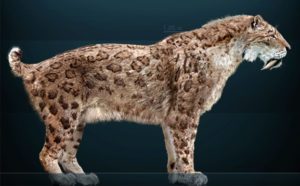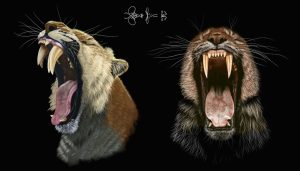Podcast: Play in new window | Download (Duration: 8:57 — 10.6MB)
Thanks to Luke for suggesting this week’s topic: Smilodon, the saber-toothed cat, AKA the sabertooth tiger!
Further reading:
Did sabertooth tigers purr or roar?
The double-fanged adolescence of saber-toothed cats
We don’t know for sure what Smilodon looked like, but it might have been something like this:

An artist’s rendition of an adolescent Smilodon with doubled fangs [picture from second link above]:

Show transcript:
Welcome to Strange Animals Podcast. I’m your host, Kate Shaw.
This week we’re going to learn about an animal suggested by Luke, the sabertooth tiger, also called the sabertooth cat since it wasn’t actually a tiger, also called smilodon after its scientific name. We’ve talked about it before, way back in episode 34, but a lot of new studies have been published since then and we know a lot more about this terrifying-looking animal!
The genus of the saber-toothed cat is Smilodon, so that’s mostly what I’m going to call it in this episode. It’s classified as a member of the family Felidae, which is the same family where you find domestic cats, wildcats, big cats, and lots of extinct animals like the cave lion, but Smilodon wasn’t closely related to what we think of as cats. There were at least three species of saber-tooth cats in the genus Smilodon that we know of, but it had many other similar-looking relatives.
Smilodon is best known from the La Brea tar pits in Los Angeles, California, where the remains of hundreds of individuals have been discovered. That’s a big reason why we know so much about Smilodon, especially the species Smilodon fatalis that lived in North America and parts of South America. An even bigger species lived exclusively in South America, while both were probably descended from a smaller species that also lived in South America.
S. fatalis is estimated to have grown up to 39 inches tall at the shoulder, or 99 cm, while S. populator stood at an estimated 47 inches tall, or 119 cm. That’s almost four feet tall. Some full-grown humans are that height! Smilodon was so stocky and heavily muscled that it probably looked more like a bear than a cat. Its had a broad head and jaws that could open much wider than most modern animals, which allowed it to deploy its most deadly weapon, its saber teeth, without its jaw getting in the way.
Smilodon’s saber teeth were as much as 11 inches long, or 28 cm, although S. fatalis typically had teeth around 8 inches long, or 20 cm. Big as they were, the saber teeth were also relatively delicate. A young Smilodon didn’t start growing its big teeth until it was about a year old, and even then it had to learn how to use them so they wouldn’t break. Luckily for adolescent smilodons, they didn’t lose their baby fangs until they were fully grown.
Most mammals only grow two sets of teeth in our lifetimes. The first set is usually called baby teeth or milk teeth. As the baby grows up, its adult teeth start growing in one at a time. The adult tooth pushes at the baby tooth until it gets loose and either comes out on its own or, in the case of me in second grade, I asked to go to the bathroom and then spent half an hour twisting at a loose baby tooth until it finally came out, along with some blood. But I got a quarter that night from the tooth fairy. (Kids, maybe don’t do that.)
In the case of a young smilodon’s saber teeth, they grew in just next to the baby fangs. Instead of pushing the baby fangs out, the new teeth grew alongside them and even had a groove for the baby teeth to fit into. When scientists first discovered preserved jaws with these double fangs, they thought it was a fluke, that sometimes the new teeth came in wrong and didn’t push the old teeth out. That happens in humans sometimes too and then you have to go to the dentist to get the old baby teeth taken out. But paleontologists kept finding these double toothed jaws, and only in adolescent smilodons.
Finally a team of scientists studied the teeth carefully and made a surprising discovery. The baby fang stayed in place next to the saber tooth until the animal was about two and a half years old, at which time the baby fang finally fell out. In early 2024 the team published their study, which concluded that these double teeth acted sort of like a set of training wheels. Training wheels on a bicycle keep a new rider from tipping over sideways, and the doubled fangs kept the saber teeth from getting bent sideways until they broke. By the time the baby fang fell out, the smilodon had lots of experience hunting properly and no longer needed training wheels.
Smilodon legs are relatively short, which suggests it didn’t do a lot of running after prey. It was probably an ambush hunter and may have hunted in groups, sort of like lions do today. Some scientists think that instead of big groups, smilodon lived in small family groups of a mated pair and their offspring, which they took care of for several years. There’s even some evidence that adult animals with debilitating injuries or congenital issues that meant they couldn’t hunt were taken care of by other adults.
Smilodon ate large animals like ground sloths, horses, deer, camelids, and glyptodonts. It went extinct about 11,000 years ago, the same time that a lot of its prey went extinct too. We don’t know what color it was, but modern cats that hunt in forested areas generally have spots while cats that hunt in open areas generally have plain coats. Since smilodon lived in a variety of habitats, from forests to deserts, its coat pattern and coloration may have varied from region to region. It also had a short tail like a bobcat instead of a long tail like most modern cats.
Let’s finish with one last important detail about smilodon. Did it purr or did it roar? Remember that modern cats can either do one or the other, not both. A tiger can’t purr, while a wildcat can’t roar. In modern cats, the difference appears to be due to the number of hyoid bones in the throat. Humans have a single hyoid bone, which anchors the larynx in place, but cats have a whole row of them. Cats that can roar have seven of these tiny bones, while cats that can purr have nine of them.
Smilodon had seven hyoid bones. Therefore, scientists assumed, smilodon could roar but not purr. But a study from 2023 suggests it’s not that simple. The hyoid bones in purring cats are shaped differently from those in roaring cats. Smilodon only had seven hyoid bones, but some of them were shaped like really big purring hyoid bones, big even for the animal’s large size. Scientists aren’t sure if that means smilodon was able to purr in a deep register, if it could roar instead but with a really deep voice compared to modern cats, or if it made some other sound that we can’t even guess at.
In other words, I’m sorry, we don’t know if smilodon roared or purred, and we probably won’t know for sure until someone invents a time machine. Personally, I like to think that smilodon could purr and roar, and that it could also meow, but in a really deep voice. MEOW.
You can find Strange Animals Podcast at strangeanimalspodcast.blubrry.net. That’s blueberry without any E’s. If you have questions, comments, or suggestions for future episodes, email us at strangeanimalspodcast@gmail.com. We also have a Patreon at patreon.com/strangeanimalspodcast if you’d like to support us for as little as one dollar a month and get monthly bonus episodes.
Thanks for listening!